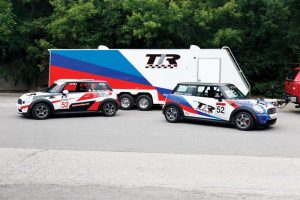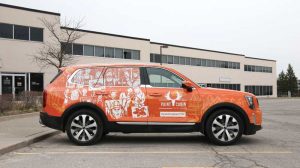Vinyl car wraps speed their way to the top
by carly_mchugh | 7 September 2023 4:33 pm
 [1]
[1]The surging popularity of vehicle wraps has opened new doors for brand promotion and artistic expression. Photos courtesy C17media
By Carly McHugh
As businesses and individuals strive to stand out in today’s bustling world, the surging popularity of vehicle wraps has not only changed the way we look at cars, but it has also opened new doors for brand promotion and artistic expression.
According to a recent report from Fact.MR, the global automotive wrap market is experiencing significant growth due to the increasing popularity of project customization and the rise in commercial applications. Currently valued at US$7.1 billion (C$9.5 billion), it is projected to reach US$ 54.1 billion (C$72.4 billion) in the next 10 years.1
For an inside look at the evolution of vehicle graphics, Sign Media Canada spoke with Chris Pereira, president of print and wrap shop C17media in Richmond Hill, Ont. Pereira highlighted the growth the market and its offerings have experienced in recent years, as well as the versatile applications now offered for both commercial advertising and personal expression.
Sign Media Canada (SMC): What do you believe is driving the popularity of vehicle graphics in recent years?
Chris Pereira (CP): I think it depends on the end result. In commercial graphics, it’s one of the cheapest ways to get viewership. Compared to using magazines and billboards, it’s a very effective way to get your brand out there.
On the personalization side, it comes down to the cost and the ability to do what couldn’t be done before. Ten years ago, doing a colour change using vinyl wasn’t really possible. The key manufacturers just didn’t have the technology or the film to make it look good, whereas now, we’re at a point where we can make it work.
When it comes to racing, livery has always been a form of expression in motorsports, but it was typically painted. You’d have your base colour—blue, white, or whatever it might be—and then you’d have pinstriping, logos painted on, and so forth. The advancement in film technology has allowed us to change from paint to vinyl wraps. Now, there are very few (if any) race cars that use paint work, aside from maybe a base colour, because that’s how the car came out of the factory. For any additional designs, it’s all gone the way of vinyl.
SMC: How do wraps compare to traditional advertising methods in terms of cost-effectiveness and overall impact?
 [2]
[2]Colour changes allow car owners to give their rides a new look, without having to repaint them.
CP: On the commercial side, there’s a very high value to doing a vehicle wrap. Obviously, this is dependent on the type of vehicle. A box truck is going to give you a larger surface area to express your brand on versus a Smart car or a motorcycle. Then, of course, you want to look at driving habits. If you’re doing a delivery vehicle, it’s a no-brainer. They should all be branded. However, if it’s something that doesn’t see the road very often, you might not get your return on investment (ROI) after you pay for the wrap.
SMC: How have businesses been leveraging vehicle graphics to enhance their brand visibility and reach their target audiences?
CP: For the most part, a lot of the brands we work with start off kind of basic, and there’s nothing wrong with that. Essentially, they might get a white or black car, and we’ll do something as simple as a cut vinyl logo for their doors and back window. The cost is very minimal, so it’s a way for them to dip their feet in and see if they’re seeing return. It’s a little bit hard to measure at times, but we find most of the customers who do that—when their lease is over, or sometimes even before that—end up returning and wanting to make a bigger statement. Instead of just a couple of logos on the car, it becomes more of a branded vehicle as a whole. We would start to wrap the entire vehicle or find a middle ground with a partial wrap. For example, the front half of the car would be left white and then the back half would be a full livery.
 [3]
[3]The automotive wrap market is experiencing significant growth due to the popularity of customization and commercial projects.
SMC: Do the same strategies apply in the motorsports and racing category?
CP: In motorsports, it’s sort of a mix of two worlds. One of them is advertising. Motorsports is very expensive to run and is funded by sponsorships, so among the race cars around the world, it’s very rare if you can find one that doesn’t have sponsor logos on it. That’s how they’re funding their race program. Instead of painting it, they’re putting vinyl stickers on. There are also the elements of the design of the car, whether it’s got stripes or whatever design they want to do. This ties into the personalization of it, which we see on some street cars, where they do just a colour change without branding. The race car combines those two worlds: personalization and wanting to stand out, and a branding aspect for their sponsors.
SMC: How have advancements in printing technology and design software contributed to the success of the vehicle graphics sector?
CP: On the software side of things, you can now get renders of a vehicle pretty easily. This is helpful in terms of sizing logos, placement, and so forth. We can also do 3D renders. If you’re doing a full vehicle wrap, it’s a decent investment. Sometimes customers want to spend the extra money upfront to do a 3D render, so they can see all the angles of the car and how everything looks prior to starting. It’s been a huge selling point, as you can get your vision across to the customer, as opposed to just having a meeting about it. Then, on the printing side of things, it’s ink flexibility. Today, an ultraviolet (UV) printer wouldn’t really be able to do a car wrap, as it would crack. However, now we’re getting inks on latex or eco-solvent printers that have the flexibility. Therefore, when you’re stretching vinyl on a bumper, the ink can actually take the stretch. They also have durability, so they’re not fading in the sun after six months. You can get three, four, or five-plus years out of the wrap, depending on what you’re printing on.
SMC: Beyond commercial applications, how have clients been using vehicle graphics to express their personal style and values?
 [4]
[4]Race car livery combines the two worlds present in the vehicle wrap market: personalization and wanting to stand out, and branding and advertising through company sponsorships.
CP: We really find the style aspect to be on the high-end vehicles, such as Lamborghinis, Ferraris, and McLarens—the reason being the budget. A colour change wrap starts in the $4,500 range, which is not cheap, so it’s obviously very tough for the average car owner to see value. However, if you have an exotic car or a sports car, you’re able to change the colour and drive it for a couple of years without actually repainting the car. There’s a lot of value there, in the sense that you have your own unique colour that potentially no other car of the same make or model in the world has. Therefore, it’s a way to stand out, but it also retains the existing value of the vehicle. If you try to sell a car that’s been repainted, the car’s value has plummeted. No one’s sure if the car was in an accident or if there were any repairs. However, the vinyl wrap is something you can remove later and retain the value. Additionally, it does offer some protection for the paint. Traditionally, you’re going to have better-condition paint after 20,000 or 40,000 km (12,427.4 or 24,854.8 mi) on a vinyl wrap car than you would if there was nothing on the paint at all.
 [5]
[5]Commercial graphics are an affordable, cost-effective way for businesses to spread awareness about their brands.
SMC: How do you see current trends in vehicle graphics evolving in the future, both in terms of design esthetics and wrap technology?
CP: There are a lot more players entering the market. We primarily use 3M vinyl, but there are tons of manufacturers now—from Avery to Orafol, and even a lot of overseas brands—which are coming out with pretty durable and consistent vinyl. I think there’s going to be a lot of competition there, which might drive the price down. Everything seems to be going up these days, so it’s hard to believe something will go down, but we might see that in the vinyl world. We’re also seeing a lot more colours than we did in the past. Avery and 3M are a little bit more committed to a core colour base, whereas some of these new manufacturers are throwing everything at it, and we’re getting hundreds of different colours to choose from, with better clarity. One of the downsides of vinyl has always been it doesn’t have the depth a really nice paint job would have, but we’re starting to see that now.
SMC: For shops who are considering offering vehicle graphics, what key factors should they take into account to ensure a successful and visually appealing outcome?
CP: The easy part is probably having the printer and printing the graphic. Obviously, there’s the upfront capital costs of buying a printer, but the real challenge is around the installation part of the job. Even if you’re working on a delivery truck, vehicles aren’t cheap, which means you have the insurance and liability of the vehicle at your facility. A lot of the wraps require the removal of certain parts—such as the door handles, mirrors, and so forth—which opens up a bit of a liability as well. Ultimately, as much as it’s getting easier, wrapping a vehicle is a pretty talented position. If you’re not post-heating properly or following the manufacturer’s recommendations on how to install it, you may successfully do it, but within a week, you’re going to have a lot of lifting and bubbles, which is ultimately going to have that car come back to you. I think training—that hands-on time—or finding a subcontractor to work with is going to be the biggest challenge to get into that market.
SMC: Do you have anything else you would like to add about the current state of the market or where you see vehicle graphics going in the future?
CP: On the commercial side, I think there’s still a lot of room for growth. We’re seeing more branded vehicles on the road, but we’re still not seeing the same percentage compared to those in the U.S. I think companies are still a little bit new to this, or not sure where or how to get it done. As a result, I think we’re going to see an increase in customer requests over the next couple of years.
- [Image]: https://www.signmedia.ca/wp-content/uploads/2023/09/DSC_8179.jpg
- [Image]: https://www.signmedia.ca/wp-content/uploads/2023/09/IMG-20210602-WA0009.jpg
- [Image]: https://www.signmedia.ca/wp-content/uploads/2023/09/Country-Style-Coffee-Promo-9500.jpg
- [Image]: https://www.signmedia.ca/wp-content/uploads/2023/09/3P1A5157-copy.jpg
- [Image]: https://www.signmedia.ca/wp-content/uploads/2023/09/3P1A4386.jpg
Source URL: https://www.signmedia.ca/vinyl-car-wraps-speed-their-way-to-the-top/